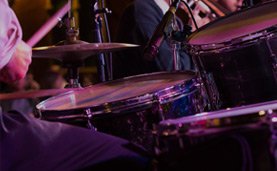10 Unsung Guitar Heroes of the 1960s

via Brian Duva / YouTube
The 1960s brought about a revolution in rock music, ushering in a new age where guitarists began to shine brighter than ever. However, while some guitarists became household names, others never quite got the recognition they deserved. Here are ten guitarists from the 1960s who played pivotal roles in shaping the era but often don’t get the credit they deserve.
Vince Martell
View this post on Instagram
Vinny Martell, who was the lead guitarist for Vanilla Fudge, had a big impact on the rock scene of the late 60s. His work on the track “You Keep Me Hangin’ On” is often seen as a bridge from psychedelia to heavy metal. Martell served in the US Navy before diving into the music scene where his talents really took off. His signature style with Vanilla Fudge combined rock with classical music influences, leaving a strong mark on bands like Led Zeppelin and Deep Purple.
After Vanilla Fudge split, Martell continued playing music. He often plays local gigs with his own band and has stayed active in the music industry. His role in Vanilla Fudge showcases how he was more than just a sideman; he was a major part of the band’s innovative sound.
Zal Yanovsky
View this post on Instagram
Zal Yanovsky of the Lovin’ Spoonful played a big part in the band’s success with chart-toppers like “Summer in the City” and “Do You Believe in Magic.” His playful and versatile guitar playing suited the band’s mix of rock, folk, and blues perfectly. Yanovsky’s approach to guitar was not about showing off; it was always about serving the song, making each tune vibrant and appealing.
Despite his big role in a major band, Yanovsky didn’t stay in the limelight for long. After leaving the Lovin’ Spoonful, he switched careers to open a restaurant, showing his adaptability wasn’t limited to music alone. His legacy, however, lives strongly in the memorable tracks of the Lovin’ Spoonful.
Gene Cornish
View this post on Instagram
Gene Cornish of the Rascals was known for his solid rhythm guitar playing. Joining the band in 1965 after a stint with Joey Dee & the Starliters, Cornish helped the Rascals become one of the era’s defining groups. Their hits like “Groovin’” and “Good Lovin’” bear Cornish’s imprint through his rhythm work and occasional lead lines that complemented the songs’ groovy feel.
Cornish continued to perform with the Rascals and other formations, showing his dedication to the music he loves. His skills often go unnoticed next to flashier guitarists of the era, but his contributions to the Rascals’ success speak volumes.
John Cipollina
View this post on Instagram
John Cipollina of Quicksilver Messenger Service brought a unique sound to the psychedelic rock scene of San Francisco. His distinct style came from his use of customized Gibson SG guitars and a complex setup of amps and effects. Cipollina’s use of the tremolo arm and fingerpicks created a vibrato-heavy sound that made his playing stand out.
His influence is still felt today, especially in bands that seek to capture the experimental spirit of the 1960s San Francisco scene. Cipollina’s guitar work helped define the sound of an era and continues to inspire musicians looking for a less conventional approach to the guitar.
Michael Monarch
View this post on Instagram
Michael Monarch was just a teenager when he helped form Steppenwolf, a band known for the iconic song “Born to Be Wild.” His powerful guitar riffs became the backbone of the band’s heavy sound, which mixed rock with a hard-edged blues influence. Monarch’s aggressive style was perfect for the emerging hard rock scenes of the late 1960s.
Despite his early start, Monarch’s role in the evolution of rock often doesn’t receive the recognition it should. His work with Steppenwolf helped pave the way for countless rock bands that followed, proving that youth is not a barrier to making a big impact.
Dick Wagner
View this post on Instagram
Dick Wagner may not be a name that every fan of 1960s rock knows, but his guitar work has touched many. Playing for The Frost, his ferocious licks and melodies were a vital part of the Michigan rock scene. Wagner’s knack for weaving intricate solos with emotive playing gave The Frost’s music depth and character.
Post The Frost era, Wagner became a sought-after session guitarist, working with legends like Alice Cooper and Lou Reed, which speaks to his skill and adaptability. His guitar work helped shape many classic songs, and his ability to meld with different artists made him a true musicians’ musician.
Erik Braunn
View this post on Instagram
Erik Braunn was the young lead guitarist for Iron Butterfly, and his playing on the iconic track “In-A-Gadda-Da-Vida” captured the psychedelic rock sound of the late 1960s. At just 17 years old, Braunn’s fiery guitar solos helped the song become a monumental hit. His ability to create such powerful music at a young age is a clear indicator of his talent and potential.
Unfortunately, Braunn’s life was cut short, but in his brief career, he left a lasting impact on the world of rock music. His contributions to Iron Butterfly displayed a level of artistry that continues to resonate with guitarists and fans alike.
Jerry Miller
View this post on Instagram
Jerry Miller was the lead guitarist for Moby Grape, a band that combined rock, blues, jazz, and country to create a distinctive sound. Miller’s guitar style was essential to the band’s diverse sound palette. He could effortlessly transition from melodic playing to ripping leads, exemplifying the versatility required for such a fusion of genres.
Despite critical acclaim, Moby Grape didn’t achieve the commercial success they deserved. Still, Jerry Miller’s skillful play remains influential among guitarists who appreciate the art of tasteful, genre-blending guitar work.
Eddie Phillips
Eddie Phillips played for The Creation, a British band that has been often overlooked despite their innovation. Phillips’s inventive use of a violin bow to play his guitar predated similar techniques made famous by Jimmy Page of Led Zeppelin. His aggressive, feedback-laden style was ahead of its time, offering a sire of hard-edged rock that would become much more common in the following decade.
The Creation never enjoyed the huge success of some of their contemporaries, but Eddie Phillips’s creativity and unique approach to the guitar played a significant role in the evolution of rock music’s sound.
Roy Wood
View this post on Instagram
Roy Wood of The Move played a crucial role in the British rock and pop scenes, with The Move laying the groundwork for what would eventually become the Electric Light Orchestra (ELO). Wood’s ability to meld catchy pop with rock and roll displayed his innovative nature, and his proficiency on multiple instruments makes him an unsung hero of the era.
While better known for his later work with ELO, Wood’s contributions to the sound and success of The Move are undeniable. His skill at crafting memorable guitar riffs and colorful musical landscapes ensured his place in rock history, even if his name isn’t as familiar as some of his peers.




















